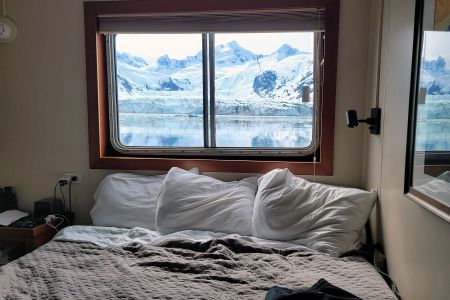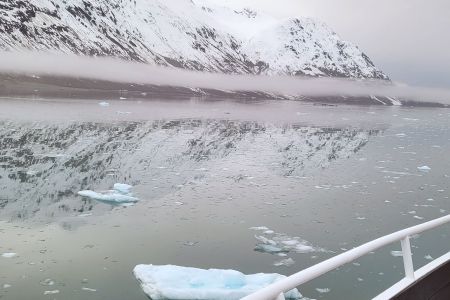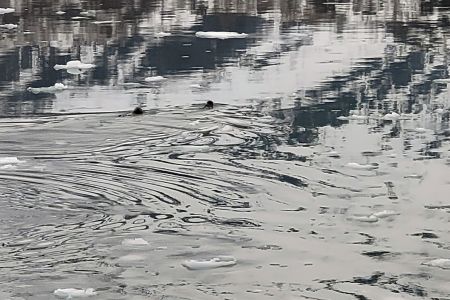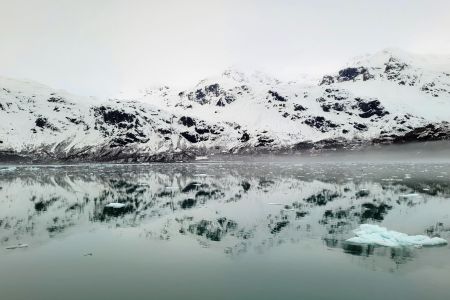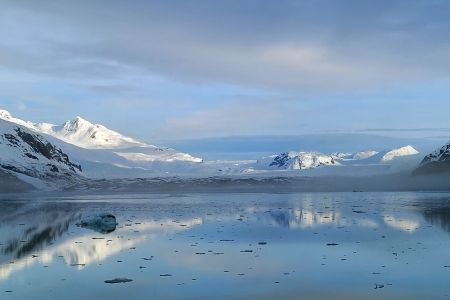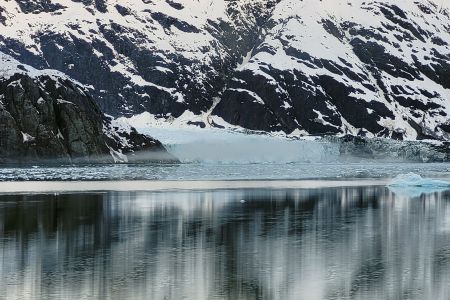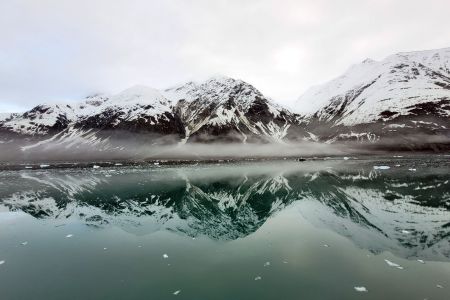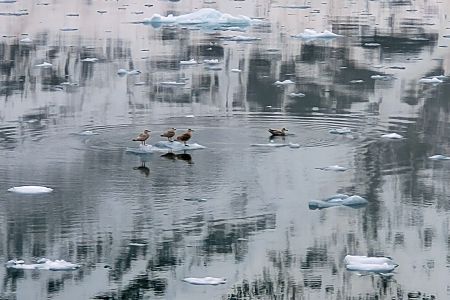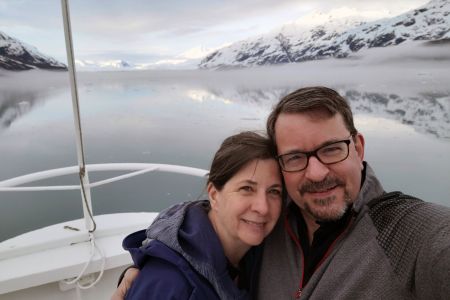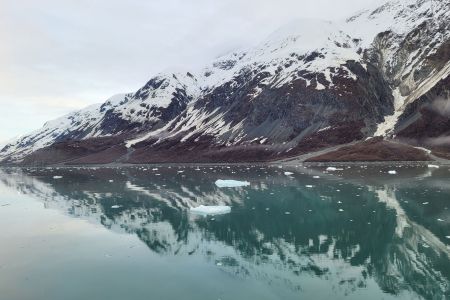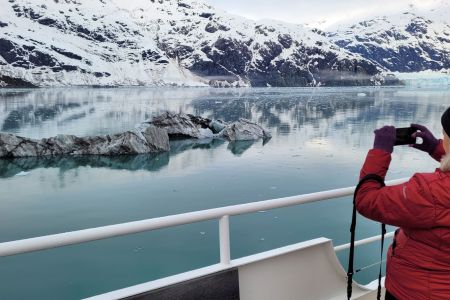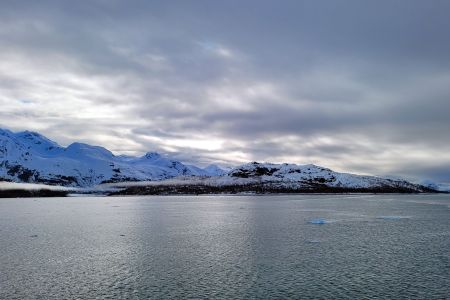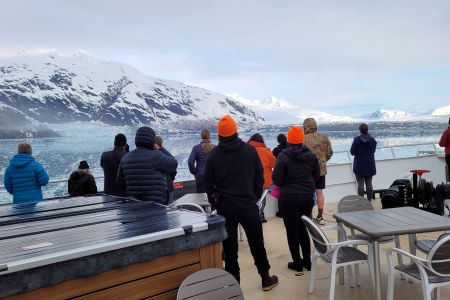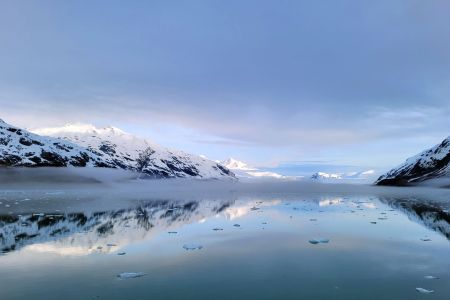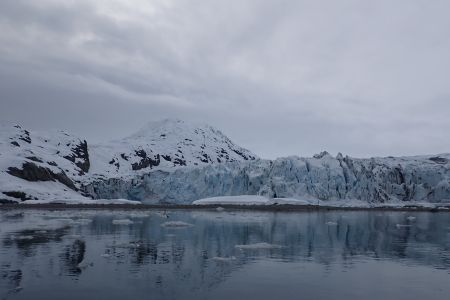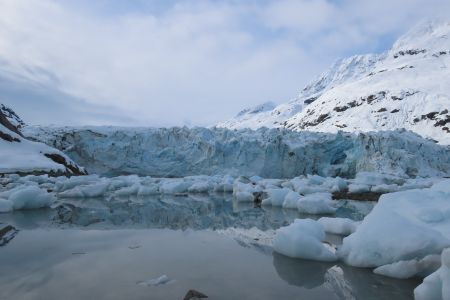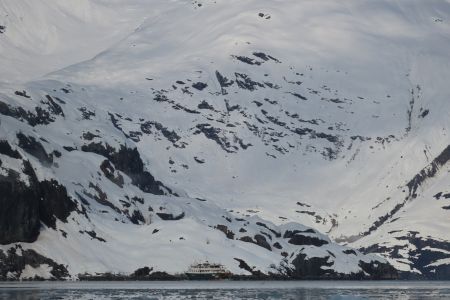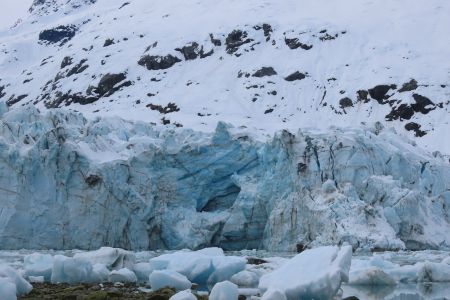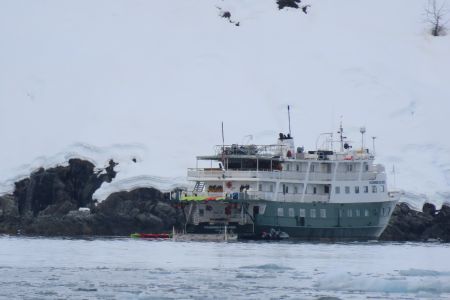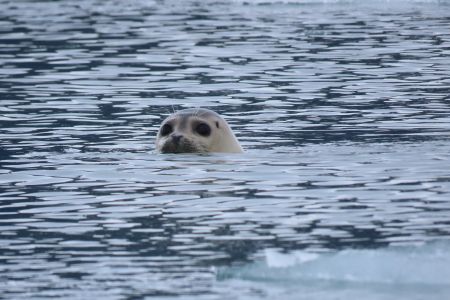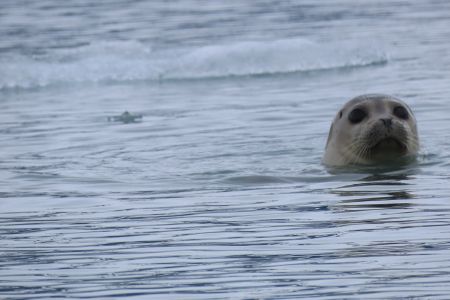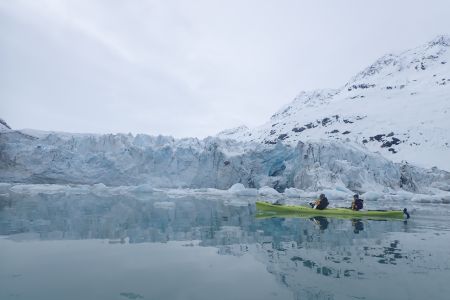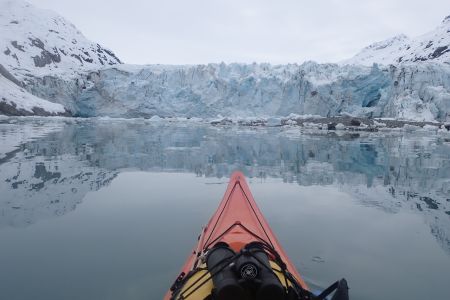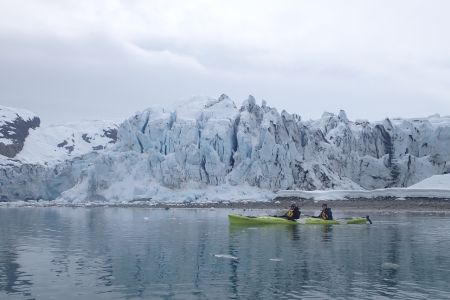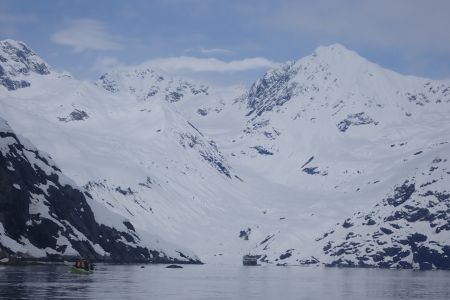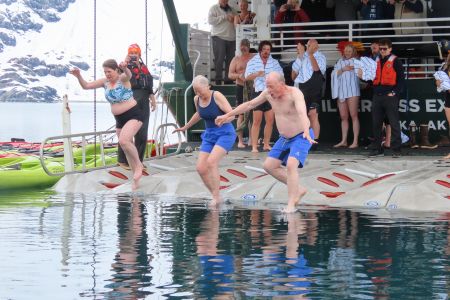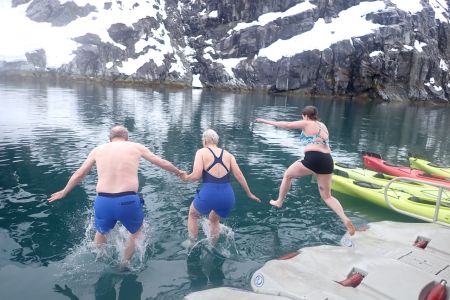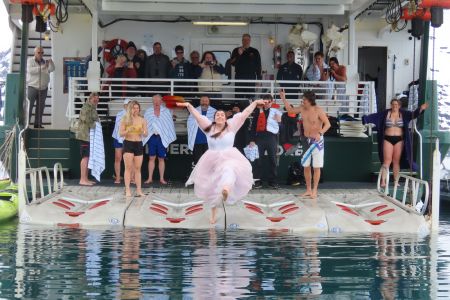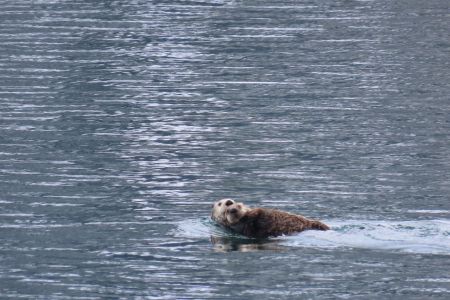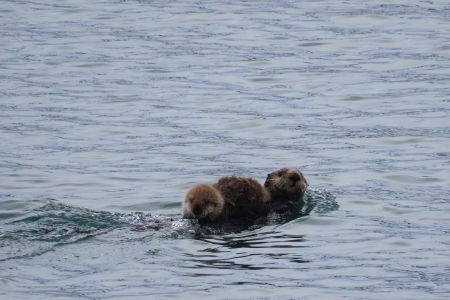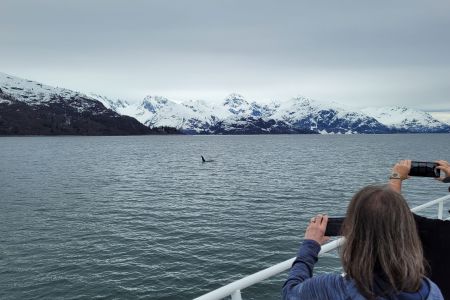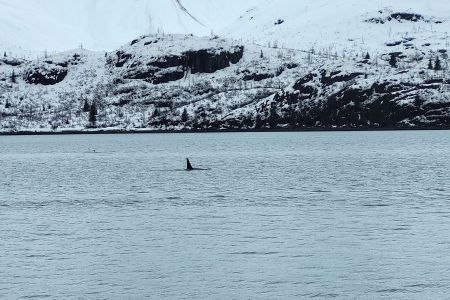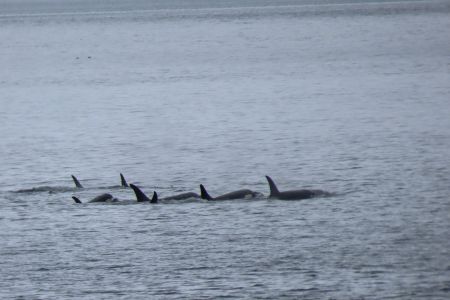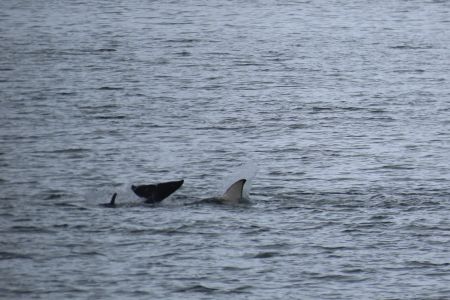
Day 6 (Saturday):
“Thar be glaciers”
It’s the second day in Glacier Bay, and the last full day on the boat. We awake to a distinct calmness. The boats engines are churning, but it’s quieter than usual. We look out our cabin window and see that we are slowly creeping up a sizable fjord. There is snow on the mountains almost down to the sea. There are icebergs slowly drifting by in the water. We hurry to get dressed and make our way out to the lounge to watch the scenery slip by us. Brittany is already in the lounge, and tells us that we are slowly making our way up to the Grand Pacific Glacier directly in front of us, and Margerie Glacier off to the left.
The Grand Pacific Glacier is thought to be the grand-daddy of the glaciers of the late “Little Ice Age” (circa 1750-ish), as the main glacier to have carved out Glacier Bay. It once covered the entirety of the bay, but now has retreated all the way back to the Canadian border. In fact, all of the glaciers in Glacier Bay but one – John Hopkins Glacier – are receding. The Grand Pacific has retreated so much, and picked up so much rock and debris that a dark brown shell of sediment covers it’s entire surface up to several inches thick. As a result, it doesn’t even look like a traditional glacier at first glance, more closely resembling a regular mountainside.
By contrast, the Margerie Glacier, flowing into the same inlet just to the left of the Grand Pacific, is a glowing white. The scale of these shear walls of ice is almost unfathomable. What we see of “Large Marge” is a wall some 200 feet straight up and nearly a mile wide. Pictures can not do the size justice, partly because the ship can only safely get within about a mile-and-a-half from the face.
Everyone on the boat makes their way out to the foredeck to take in the majesty of these two glaciers. The air is crisp and still. The water is almost glasslike, reflecting the high sides of the fjord. The captain has slowed the boat even more, the engines even quieter, and every once in a while there’s the eerie scraping of icebergs along the side of the boat. Birds perch ontop some of the bergs, unphased by our passage. Sea Otters do the backstroke in circles around us, many carrying large babies on their bellies. It’s surreal travel through a surreal environment.
We take one last long look at the two glaciers in front of us, before the captain begins to slowly turn us around and back out of the Tarr Inlet, as we head toward the Lamplugh Glacier to the southwest.
Once we arrived at Lamplugh, the crew drops anchor.
The ops offered today are a walk along the moraine, and guided kayaking up to the glacier. Margaret and I opt for the kayaking.
One with the glacier
When it comes time to take out the kayaks, we meet up with Mickie on Aft 300, along with Dave and Margy, and Reed and Karen.
As soon as our kayak slips quietly into the water, it’s obvious that this experience is quite different than the previous kayak outings. The sea is dead calm. The wind is still. Because of where the ship is able to anchor, as we paddle toward the face of the glacier, we leave it far behind.
We pass several groups of birds, when they are suddenly startled and take to wing in a low flight just over the surface of the water. Otters pop up from their deep dives to the bottom of the inlet, and then just as quickly disappear again. We can hear small rocks tumbling down the cliffs in small avalanches.
We paddle along the cliff shore, edging up to the front of the glacier face and the moraine. Every so often we hear some clicking and creaking from the glacier itself. For safety, we have to maintain a distance of a mile-and-a-half or more, but even at this distance in a kayak, the height of the wall is massive. We get as close as we can, take some photos, and stare in awe. The colors of the glacier face are extraordinary; from a pure, glaring white to a deep turquoise, to an otherworldly cobalt blue reminiscent of some kind of Mountain Dew.
We paddle for a few minutes more, and then Mickie encourages us to put our paddles down and simply let the flow of the tide take us slowly away from the glacier. This was perhaps the most ethereal experience I’ve had in my life. We are alone, the only 7 people out on the water at that moment. Drifting silently in this giant snowy fjord. We hear the small splashes of sea otters as they pop up to float with us. The occasional rubbing of ice against our hull. Other than that, dead silence. We move at the will of this frozen, glassy sea, in the middle of this deep crevasse between these otherwise towering mountains surrounding us on all sides. So quiet I could probably hear my heartbeat, if I wasn’t so damn relaxed.
We float like this for almost 20 minutes, our kayak slowly rotating 180 degrees, back to look at the glacier face as we retreat further and further away. It would’ve been a perfect place to lull oneself to sleep, except that your eyes are so wide in wonder that you could never get them closed.
“Sorry to say, it’s probably time we start heading back,” Mickie whispers, so as not to startle us. For the first time, we look back to the boat. It seems so impossibly far, a tiny green and white spec against the the white and black rocky mountains. We again begin paddling, not hurried, just calm and steady, not really ready to leave the magic of this water. But we are back at the ship before we know it, lining up lazily with the EZ Dock while the deckhands wrangle us onboard once more. And just like that, our communion with this fjord and the glacier that created it, has come to an end.
The Polar Plunge
Once we are back onboard, we return to our cabin to take off our kayaking gear. It’s not long before the message goes out that the crew is preparing for the tradition of the Polar Plunge. Anyone onboard – staff, crew and guests – have the chance to jump off the boat into the frigid glacial water. We had heard of the plunge from the very moment we embarked last Sunday. Much of the talk during happy hours, meals, and outings had been “will you or won’t you”. Margaret decided fairly early on that she was game; a chance of a lifetime opportunity to actually swim, however briefly, in Glacier Bay. Carl, on the other hand, had his doubts.
So when the time came, Margaret donned her swimsuit, and Carl promised to videotape. We assemble on the fantail, the EZ Dock lowered to provide ample real estate for the divers. Erin is the Master of Ceremonies for the event, and lays out some ground rules. “No more than four in a group at a time… wait for the signal for your group to jump… don’t jump ontop of anyone else”. The crew had positioned a skiff in the water just off the stern, both for safety and as a platform for videography. Erin’s final word of advice: “once you’re in the water, there is really no graceful way to get back out… just do the best you can”.
And then there were countdowns. “3… 2… 1”, the first group jumped. There was much flailing, but everyone made it back onboard. “3… 2… 1”, another group was in and out. The crew participated as well; expedition leaders, stewards, even the Captain took his turn going into the drink. Several more groups plunged, and then Margaret made her way to the edge of the boat, wondering what she had gotten herself into. “3… 2… 1” and she was in. As soon as she was back out, she was off to hop in the ship’s hot tub on the foredeck.
The event continued as everyone got a chance to jump, until finally it was Erin’s turn. She disappeared into one of the aft chambers of the boat, and reemerged dressed in a white and pink Princess dress, made her way to the EZ Dock, gave a Queen’s Wave to spectators, and then leapt soundly into the water.
A good time was had by all, with broad smiles all around. There was no pretense surrounding the temperature of the water. None of the traditional justifications such as “oh, it was fine once you were in”, or “you barely noticed it”. Everyone was roundly in agreement that “no, it was just fucking cold”. And with everyone back safely onboard, it was time to pull up anchor, saying goodbye to Glacier Bay.
One final, mandatory stop
Apparently when you agree to take a cruise ship into Glacier Bay, the park stipulates that one of the things you must do is take a slow pass by South Marble Island. The island is a sanctuary for all sorts of wildlife, and I guess they consider it a sort of public service announcement for cruise passengers to view conservatorship in action. So, we do our part. The island itself is not large, but is full of huge Steller Sea Lions lounging on the large rocks at the shore, cormorants nesting on the impossibly steep and craggy cliffs, lots of various types of gulls, and - we’re told, later in the season – many Puffins.
One of the reasons the cormorants prefer to make their home here is that there is plenty of low vegetation, the leaves and stems of which they can use for their nests, but there are very few tall, established trees, which means very few Eagles. And Eagles are one of the cormorants main predatory foes, stealing the cormorants eggs and young while the parents are off fishing. So you can see why South Marble Island is so appealing.
And, in fact, while we were passing, an Eagle made a rare appearance out toward the island and was summarily drummed off by hundreds of protective cormorants and gulls. They filled the sky for a good 15 minutes, making all kinds of racket, swooping and diving on the Eagle until it finally flew off to find some easier, quieter food.
A blockade of Sea Otters
The ship sailed past the tip of South Marble Island, and everyone returned to the comfort of the lounge. The captain had turned up the throttle for about 10 minutes for the long trip back to Juneau, when we all heard the engines go quiet. More curious than alarmed, no one could figure out why we were slowing down. Then, over the god mic, came the Captain: "we appear to have a blockade of Sea Otters off our bow".
We rush again out to the foredeck, and indeed, there were 3-dozen otters, maybe more, lined-up in an arc about 50 yards in front of the ship seemingly to block our progress. When one would duck their head under water, three more would pop up.
Now, realistically, the more logical explanation was these otters were just fishing in a prime spot in the inlet, grouped together because that's where dinner happened to be. But much conversation was had about how it appeared they didn't want us to leave. We were reminded momentarily of the Redwall books our children used to read, about the rodents and other small anthropomorphic animals forming armies, donning armor, and defending their cities. These otters were the marine version of Mossflower Wood!
The Captain, reluctant to run over any of these critters, kept the engines at minimum until the otters had finally scattered and the path was again open for travel. And with that, he opened the throttle again and we were on our way.
"Now if only we could see Orcas..."
As everyone filed back into the lounge from the foredeck, after our encounter with the otter brigade, conversation continued about all the wildlife we'd seen on our adventures throughout the week and today in particular.
Dave, looking every bit satisfied, jokingly stated "now if only we could see Orcas, this would officially be the best cruise ever".
Not 5 minutes later Brittany calls over the god mic "killer whales at 2 o'clock". She had spotted a large, lone male, identifiable by it's tall, straight dorsal fin, swimming close to the ship. Dave slapped the arm of his chair enthusiastically and screamed "now we're talkin'!" Back out to the foredeck, binoculars and cameras in hand, to see if we could catch a glimpse.
The male Orca was surfacing too often to be feeding, and Brittany surmised that he was checking the boat out to assess whether it was a threat. And sure enough, a few minutes later, we spot a pod of ten or a dozen more Orca, swimming in the same direction as to male, giving the boat a bit wider berth. The male had noticed the ship and swam ahead to scout it out, to determine if it was safe for his family to follow.
The pod consisted of several females, and a number of baby Orca, who were playing and slapping their tails, blissfully unaware of the heightened alert of the big male.
The Captain turned the boat to follow for a bit, not wanting to scare them or drive them off. The pod did not hurry, though. It took a good 20-30 minutes for them to swim completely by the boat, before the Captain returned to his original course out of Glacier Bay and back to Juneau.
"I'll take 'Skookum Jim' for $800, Alex"
After dinner was the traditional Trivia Night. Mickie and Kelsie (who was inexplicably dressed as a chilli pepper) were the emcees. We broke off into teams of 4-6, decided on a team name (we chose the “Gloomy Knobs”) and answered a series of trivia questions. There were questions about what we’d learned during the various after-dinner presentations, about what we’d seen during our outings and adventures, and about Alaskan and native history. The Gloomy Knobs came out ontop, of course, beating the Barnacle Penises (yes, I said it), and took home the trophy for a job well-done.
Well... okay... there was no trophy, but Margaret and I returned to our cabin to begin packing our things, and went to bed feeling happy, satisfied, and accomplished.

